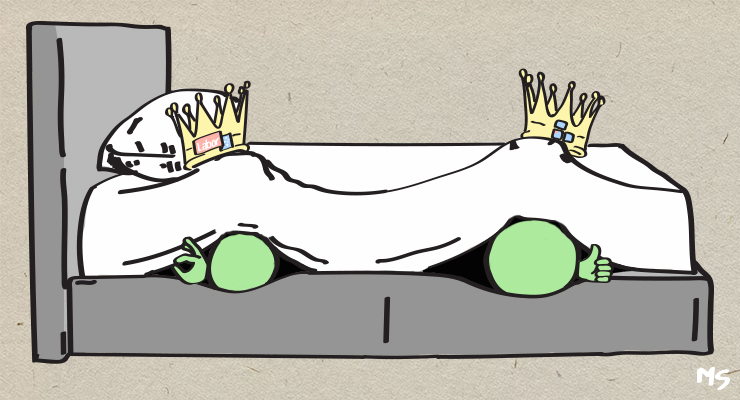
As the campaign approaches the halfway mark, pollsters whose projections range from a Labor landslide to a potential hung Parliament are consistent on one point: the minor party and independent vote is set to reach record heights.
The likelihood that nearly three in 10 voters will opt for either of the above adds a large band of uncertainty around the two-party preferred numbers, which is one reason among many that Labor is keeping its enthusiasm on a tight leash.
Much will depend on the balance of support among the various minor party contenders and the ultimate destination of their preferences, which pollsters often find hard to pin down.
An exception might perhaps be made for the known quantity for the Greens, whose national vote share again looks set to land somewhere around 10% and 11%, at least 80% of which will assuredly flow to Labor.
However, things are considerably murkier among the crowded market of would-be demagogues pitching for support at the rightward end of the spectrum.
One significant difference between this election and the last is that One Nation has candidates in all but two of the 151 seats, compared with 59 candidates in 2019. With polling offering no indication that its support has fundamentally changed since 2019, One Nation’s national vote should inflate from 3.1% to something more closely resembling its Senate vote of 5.4%.
If the extra comes mostly off the Coalition, and if this results in an even stronger flow of preferences than last time, the Coalition’s apparent loss of at least five points on the primary vote could prove less disastrous than it looks. But these are both big ifs.
Then there’s Clive Palmer, whose United Australia Party emerged with nothing to show for its spectacular advertising spend in 2019, but is now targeting a real constituency with messages that aren’t simply de facto Coalition attack ads.
While the polls offer no encouragement that Palmer will achieve any more than last time in terms of seats, a look beneath the surface suggests the support he has garnered among COVID liberatarians and conspiracy theorists is an unpredictable new element in the equation.
Palmer’s support base is in many ways distinct from Hanson’s: neither are popular among the university educated, but the older cohorts that continue to provide Hanson with much of her support tend to be inoculated against both COVID and the quackery promoted by Palmer in response to it.
That Palmer makes no specific appeal to nativist sentiment is also reflected in the fact that his party’s numbers are if anything stronger among non-English speakers.
Even more telling is the uneven geographic spread of Palmer’s support, which is strongest in the progressive bastion of Victoria and weakest in normally conservative Western Australia.
In Palmer’s home state of Queensland, where he will square off against Hanson in the Senate race, the most recent Newspoll breakdown had One Nation trouncing the UAP by 8% to 3%.

The unstable element of the minor party vote is weighing heavily on the campaign strategies of the major parties — particularly the Liberals, who are finding a path to victory particularly difficult to plot.
Among many other things, this explains why the Liberal brains trust has been unconcerned that so much campaign oxygen has been taken up by the Katherine Deves controversy.
The issue appears to be exacerbating the difficulty the party faces on its opposite flank from the teal independents, and all but assuring the reelection of Zali Steggall in Warringah.
But as a number of reports out of the press gallery have indicated, party strategists are convinced the issue is having an even stronger impact as a reverse virtue signal to culturally conservative supporters of minor parties, whose preferences are clearly considered up for grabs.
William Bowe is conducting paid consultancy during the federal election campaign for Climate 200, which is helping fund independent candidates who support policies to promote renewable energy and mitigate climate change.








Palmer’s campaign ads are hard to fathom, what do they mean? The few I’ve seen appear to be brief lines on a wish list ie: bring Super back to Australia, Freedom, Home Loans capped at 3%. No explanation of how any of this may come about, just meaningless marketing grabs.
As a hat – what does a fascinator mean.
How would Kafka have framed that question?
An oft missed point about Kafka’s tales is that they were NOT about a malevolent state.
His protagonists were unable to even interact with an utterly uncaring, non responsive bureaucratic hegemony that never explained, never apologised, to any who came within its purview.
All were crushed beneath its lumbering mass, like the Jagganth rath and it just did not notice, never mind care.
The deadline for revealing a candidate’s preference distribution will be very revealing of the Fat Miner’s cunning plan – for those who have been living under a rock for the last decade or three.
One suspects UAP will tank as in 2019. More interesting will be a teal blast. It could be the hard right Libs’ denouement, à la the ALP split, 2022 or 2023 being 1957 relived in a mirror
The UAP didn’t tank in 2019. Palmer had no intention of winning any lower house seats and was probably hopeful of an outside chance of a Senate seat. He just didn’t want Shorten to win so he could pay less tax and not be held accountable through investigation that an incoming Labor government might launch into Mineralogy or his other companies and their affairs and assets. In that he was successful. He knew what he was doing and won that way.
People are short sighted and foolish if they don’t think about the reason why powerful people do things and see only the headline news: Palmer loses bid. Yeah! And save himself millions into the bargain.
The Fat Miner is hoovering up the disgruntled lumpen to use their preferences to keep Scummo in power
Even more galling is that every zac of his election advertising & expenditure, 2019 & now, will be written off as tax credits.
IOW, we pay for him to cheat us.
Yes. Culturally conservative supporters of both parties. Faith based people in electorates. Whities in the Hills and the Shire – Mitchell and Cook. Overwhelmingly Christian. CALD communities in the poorer, more congested urban electorates, mainly but not exclusively Labor. Often Christian but from persecuted or endangered religions in mainly Arabic countries. Muslims from all over Asia and Africa. Buddhists and their derivatives from Asia and Hindus from Asia. All of it a toxic mix.
And conservatives from all types, usually White and Christian, in regional and rural areas. No chance of Independents there unlike the marvellous Windsor and Oakeshott from 2010. Barnaby appears safe. Rural electorates are home to toxic Nationals largely which is a shame and a deterrent to wanting to live there. Labor doesn’t just show disinterest in the interests of people from wealthy areas who haven’t voted for them in decades if not generations. It also has shown disinterest in the needs of rural and to an extent regional constituents. Similar to the Greens. I used to see the Greens candidate in my local electorate in the Hawkesbury give her venomous, bile-filled speech to no-one as she gives praise to the gospel according to Karl Marx, Lee Rhiannon and Joseph Stalin without mentioning once the needs of the electorate and there are many. To be fair, neither did the ALP or Liberal candidates or the Star Wars bar-room scene of candidates who were Independents or from other minor or micro parties.